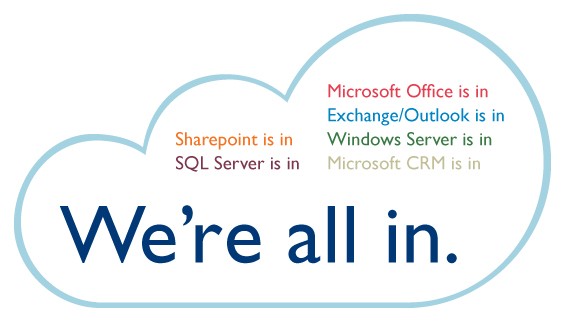Microsoft Cloud Solutions
This time Microsoft could see the future ahead and played wisely: it is the only company that is offering a 360 degree cloud coverage with its offerings. This is not a pure Microsoft appraisal, I will also talk about the competition and see why I have concluded that Microsoft offers firm cloud solutions.
Infrastructure as a Service
This is the stronghold of Microsoft with its System Center suite of products. With System Center, you have everything you need to build, deploy and manage your infrastructure:
- System Center Configuration Manager (SCCM): SCCM enables you to inventory your existing Information Technologies infrastructure, deploy applications, operating systems remotely, manage mobile devices, manage compliance and make baselining. With SCCM 2012, there is the concept of user-centric management, based on the notion of “consumerization of IT.” You can target software to users and their software selection will follow them on each device they log in; no matter if this device is their primary device or not. With the implementation of power management, you can define policies to reduce your company’s power use by shutting down the unused systems.
- System Center Operations Manager (SCOM): SCOM is by far the most comprehensive monitoring solution for Microsoft environments. With the acquisition of Avicode, the realtime .NET Application Monitoring startup, Operations Manager 2012 now goes beyond the systems and network monitoring to application monitoring. The application is discovered and monitored to the code level: the developers can now see which exact SQL statement or .NET code is slowing down the application. SCOM also supports monitoring network devices and UNIX/Linux computers (certain distributions.)
- System Center Virtual Machine Manager (SCVMM): “Datacenter Manager” might be a more appropriate name for the VMM. Although its name implies that VMM only manages virtual machines, it is not: VMM manages your entire entire datacenter as a fabric of resources and lets you provision the add›itional resources with minimum effort. You can create clouds, optimize resource usage at the top level and also manage your storage at the LUN level.
- System Center Data Protection Manager (SCDPM): Data Protection Manager is Microsoft’s backup solution designed for Microsoft environments. The important thing to note here is the “Microsoft environments.” Do not expect to use SCDPM for UNIX, Linux computers. In the Microsoft products, the abilities of SCDPM is as expected such as faster backup/restore of SQL databases, item level recovery in Sharepoint, hardware snapshot on SAN (using hardware VSS provider), etc.. Although it is still rough on some edges, it is a solid backup product for Microsoft environments.
- System Center Service Manager (SCSM): Service Manager enables you to standardize and monitor your services with incident, change and problems management, comply with industry needs.
- System Center Orchestrator (SCO): Orchestrator is the best name chosen for the product because what really does is to automate the routine tasks, workflows and processes across your Information Technologies infrastructure. You can define role-based services, automatically route requests, automate provisioning and integrate services with the third-party software components.
RELATED: Choosing a Cloud Provider
The real power of Microsoft’s System Center suite is not the sum of its individual products but their integration with each other. Surely your business flows are different, but this example will give you an idea on the power of integration. As IT department you create a workflow to deploy a new virtual PC for a new employee (SCO.) HR will fill the required form and create a ticket (SCSM) which will be routed (SCO) to the relevant people in IT for approval. After the approval (SCSO) a new machine will be created according to the predefined policies (SCO, SCVMM), operating system will be deployed and the applications (according to the user role) will be installed (SCCM), Active Directory account will be created (SCO), the PC will be specified in a backup group (SCDPM, SCO) and then the ticket will be closed and the HR and IT departments will be notified (SCO, SCSM.)
This does not need to happen in your private cloud. You can define the steps to utilize your private cloud and your public cloud. System Center suite supports public, private and hybrid clouds.
Of course there is the competition, and there are products that individually perform better than a particular System Center product. You may argue that Cacti can monitor network better than SCOM or SalesForce provides a better ticketing solution than SCSM, or VCloud can manage your virtual infrastructure better than SCVMM. I do not disagree. I just try to say that System Center has an excellent integration between its applications. You do not need to integrate anything, this is already done. I also say that the suite is very comprehensive so that it leaves almost nothing to be desired. But of course, if you need the “better” items that are offered by the other vendors, it is only you that can evaluate which offering suits better to your environment.
RELATED: CIO Perspective: What are Your Cloud Questions?
Platform as a Service
If you need databases to develop applications, why would you bother with managing servers? Windows Azure does just that: it gives you the databases and the development platform so that you can focus all your efforts to development, not managing servers.
Microsoft plays with Windows Azure in the Platform as a Service (PaaS) market. Windows Azure is a service that allows you to create and deploy applications and to locate your SQL Server databases. As expected, it uses the .NET environment. With Azure AppFabric, you can connect your Local Area Network (LAN) to the Azure platform and use many roles in your LAN such as Active Directory authentication, certificate uses and the like.
The competition in this market is tough compared to the Infrastructure offerings. The barrier to implement the PaaS offering is the architecture first. If you are developing PHP code on a LAMP stack, it is obvious that Windows Azure is not a fit for you. In this scenario, you will most probably choose Red Hat’s OpenShift over Windows Azure. Or if you are developing for Google Apps, then it is AppEngine that you will consider. Or of DB2 applications, the solution will be Workload Deployer.
The choice for the PaaS solution is not a pure IT decision; it is the business that decides on the platform. If a company is founded to develop and sell applications for Google Apps, then it will not make any sense to choose Windows Azure for development. Similarly, if the company uses Microsoft environment to the full and develops applications with .NET and SQL Server, then it will be of no use to choose -say- Workload Deployer as the PaaS solution.
RELATED: Are WordPress Themes Beating Out Individually Designed Websites for Small Businesses?
Software as a Service
The familiar spreadsheet application Excel is on the Web. Although lacking some features from the full-featured desktop application, Excel WebApp is very sufficient for the majority of the users.
This area is where all the hell breaks loose. As the largest Software as a Service (SaaS) providers also have their own mobile and desktop platforms, the competition is way fierce. Although Apple is also in the SaaS arena with its cloud solution (iCloud), I will take a business oriented point of view and consider Microsoft and Google.
Google offers its Google Apps for Business, and Microsoft offers Office 365. Google was the first to market and you can easily see that Google Apps is optimized for online use. On the other hand, Microsoft brings its experience on the business side to the table and brings a familiar Microsoft Office experience online. Google Apps is made mobile on the Android platform and Office 365 on Windows Phone and Windows 8 platform.
The two giants offer almost identical services inside their SaaS offerings. Google is more mature but Microsoft is taking very solid steps to establish its presence. I cannot conclude a clear winner in this area; but if you are planning to migrate your existing Microsoft-based infrastructure (Exchange, Sharepoint, Microsoft Office) to the cloud, then I can say that Office 365 will make this migration less painful.
The Final Word
As we have just scratched the surface in the cloud solutions and the cloud market, I can safely repeat that Microsoft is the only company that has presence in all markets. Taken at the granular level you can find products that perform better than Microsoft in certain areas but in the broadest perspective Microsoft is alone.
When I take a step back and evaluate the cloud environment from an objective perspective, setting the business decisions aside as we have discussed in the PaaS section, I can safely say that Microsoft offers a less painful transition and with a known, well-backed Microsoft support.
My heartfelt congratulations goes to Redmond.
Image Credits
- Inline Image: Windows Azure Platform, Microsoft Developer Network, http://msdn.microsoft.com
- Inline Image: Excel Web App, Microsoft Office 365, http://www.microsoft.com/en-us/office365




